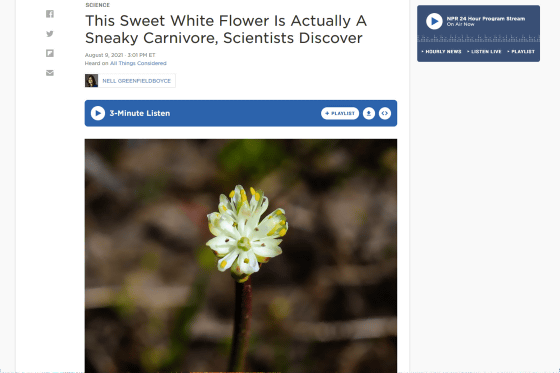It turned out that the plant known for more than 100 years was actually a 'carnivorous plant', and it was catching insects with stems instead of leaves.

by Danilo Lima
A plant called Triantha occidentalis (western false asphodel) of the Tofieldiaceae family , which has been known for more than 100 years and is widely inhabited in the suburbs of North American cities , is actually a carnivorous plant that captures insects and uses them as nutrients. It was discovered by research teams at the University of Wisconsin-Madison and the University of British Columbia. Triantha occidentalis is said to catch small insects with sticky stems, unlike common carnivorous plants that use special leaves to catch insects.
A new carnivorous plant lineage (Triantha) with a unique sticky-inflorescence trap | PNAS
https://www.pnas.org/content/118/33/e2022724118
New carnivorous plant must balance trapping prey and being pollinated | Eurek Alert!
https://www.eurekalert.org/news-releases/924735
A Common North American Plant Was Just Discovered to Be Secretly Carnivorous
https://www.sciencealert.com/a-new-carnivorous-plant-has-been-discovered-in-north-america
1st Carnivorous Plant Identified In 20 Years Grows Near Vancouver: NPR
https://www.npr.org/2021/08/09/1026091196/this-sweet-white-flower-is-actually-a-sneaky-carnivore-scientists-discovered

Triantha occidentalis is a plant that is widely distributed on the west coast of North America and inland Montana, and grows mainly in swamps and wetlands. Triantha occidentalis, which grows close to major cities such as Vancouver, was first mentioned in the scientific literature in 1879, but was not previously considered a carnivorous plant.
However, while working on a profile on plant genetics, a research team led by Professor Sean Graham , a botanist at the University of British Columbia, discovered a mutation in the Triantha occidentalis gene that is common in carnivorous plants. In addition to this discovery, the research team found that Triantha occidentalis is a carnivorous plant because the place where Triantha occidentalis grows meets the conditions for carnivorous plants to grow and the stems are sticky and small insects adhere to it. He said he started thinking about a certain possibility.
The white flowers in the photo below are Triantha occidentalis. The thick stem is sticky, and small insects seem to stick to it.

by Danilo Lima
To see if Triantha occidentalis is a carnivorous plant, the research team conducted an experiment in which fruit flies were made to take up nitrogen-15 , a stable isotope of nitrogen, and attach it to the stem of Triantha occidentalis. After that, when the nitrogen contained in Triantha occidentalis was analyzed, nitrogen-15 taken up by fruit flies was discovered, and it was confirmed that it actually took in nutrients from insects. The research team estimates that Triantha occidentalis was obtained from insects that captured about 64% of nitrogen.
The research team also found that the sticky hair on the stems of Triantha occidentalis secretes a digestive enzyme called phosphatase. Phosphatase is a digestive enzyme that is also used by other carnivorous plants and decomposes phosphorus-containing nutrients in its prey.
'The unique thing about this carnivorous plant is that it catches insects near the pollen-borne flowers,' said Qianshi Lin, a research team. Normally, carnivorous plants such as Venus flytrap have traps far from the flowers so that they do not interfere with pollen transmission by insects.
However, Triantha occidentalis has a stickiness of the stem that 'small insects that are not so beneficial for pollinator can be caught, but large insects such as bees and butterflies that function as pollinators cannot be caught', and pollen. It seems that it is possible to select and catch only insects that do not mediate.

by Qianshi Lin
This is the first time that a carnivorous plant in the order Sagittaria trifolia has been discovered, and Professor Graham states, 'I never thought that Triantha occidentalis was carnivorous.' Since carnivorous plants that grow near the city have been overlooked for many years, there may be many other plants that are not noticed as carnivorous plants.
Harvard botanist Aaron Ellison, who was not involved in the study, commented that the findings were the result of 'a truly wonderful chain of scientific thinking.' The discovery of Triantha occidentalis, which uses stems to catch insects, is 'quite surprising,' he said, as known carnivorous plants use special leaves to catch insects.
Related Posts:







